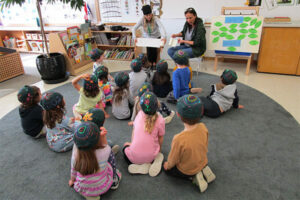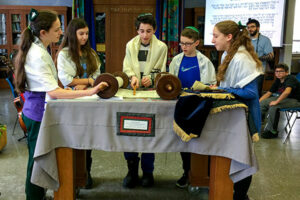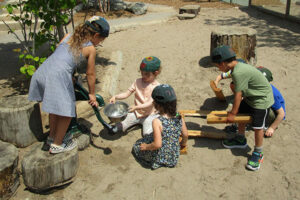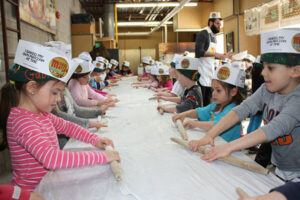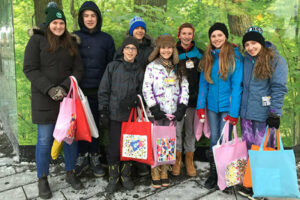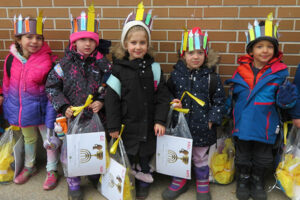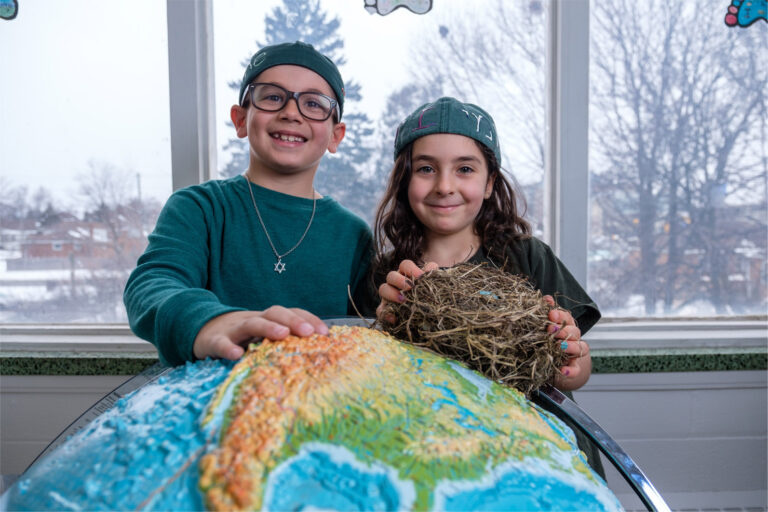Our Meet the Community blog column gives Heschel families the opportunity to get to know some of the people who make a difference at The Toronto Heschel School.
In honour of Tu Bishvat and Heschel’s Environment Week that is taking place now, this month’s edition features Moreh Yarden Bourlas, Grade 8 teacher and environmental education lead.
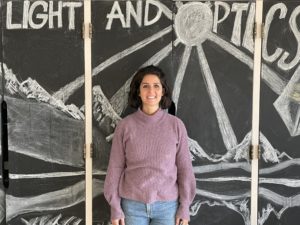
Heschel Hive (HH): How long have you been at The Toronto Heschel School and what do you teach?
Yarden Bourlas (YB): I’ve been at Heschel for about four years. I was a mid-year maternity leave replacement for Grade 3 and then moved to Grade 8, which I still teach. I also take care of our school garden and am in charge of the environmental education program.
HH: What did you study at university, before earning your Masters of Education?
YB: I took a Bachelor of Science in Environmental Science. I focused on atmospheric science, with a minor in Conflict Resolution Studies.
HH: So has the minor come into use in your role at Heschel?
YB: Every day!
HH: Tell us about your role with Heschel’s environmental program.
YB: I’ve always felt connected to nature; I love being outside, hiking, and camping. As a young person, I was worried about what we were doing to the planet. So it felt natural to study how ecosystems work and human impact on them.
I started out working in the nonprofit sector for the Canadian Parks and Wilderness Society and The Wilderness Committee in a fundraising capacity. Both organizations protect forests in Manitoba, where I’m from. Eventually, I felt overwhelmed by this type of work—focusing on the world’s problems can take a lot out of a person.
I needed a break and I changed direction. I ended up going to teach English in Korea and left all the environmental stuff behind. When I got my job at Heschel, my love for environmental protection and stewardship was reignited and I put my skills to use again—in a new context, with young people.
HH: What is your favourite element of the Tu Bishvat Seder and Environmental Symposium?
YB: The best part about Tu Bishvat—especially, how we celebrate it in Canada—is its quality of renewal. Tu Bishvat is one of the four Jewish new years; it’s a new year for the trees. Trees are incredible. They are so complex and enormous; they inspire awe in all of us and provide calm and stability. In the deep freeze of January in Canada, when we are stuck inside and maybe getting a little down, celebrating a new year for the trees—with beautiful fruits, foods, and floral decorations—brings spring to us earlier and lifts our spirits.
In general, my approach to environmental education is positive and celebration based. This is different to the doomsday approach that that I grew up with, which causes people to alienate further from environmental protection, so what I love about Tu Bishvat is its celebratory nature.
HH: We’ve seen you commute to school on an e-bike. Do you take to two wheels in all seasons, and if not, when do you stop?
YB: I don’t ride all winter long. When I first got the bike, I said -5 ᴼC was my cutoff, but I’d actually push it and bundle up. This year, I changed my cutoff to 5 ᴼC. If it’s lower than that, I don’t ride.
HH: What do you think is your biggest personal contribution to planetary wellness?
YB: We all carry a lot of pressure as individuals to solve the world’s environmental problems. While individual efforts matter, the truth is that no one can do it on their own. This is how I approach my education with students; I don’t want to promote a personal shouldering of the world’s problems. It’s dysregulating and demoralizing. When we educate people in such a way to say: “Recycle, get your bags, do this and do that,” people internalize a tremendous amount of guilt. They feel that if the world is not getting fixed, and they didn’t do the bag thing, it’s because of them. This is our natural psychological orientation and I don’t think it’s helpful or healthy.
This is not to say that I think everybody should give up and not change how we treat the natural world—we definitely should. In light of this, my biggest personal contribution is my role as an environmental educator. In science class, I teach my students about how nature works. I also bring them into the garden, where I teach them about the cyclical nature and vulnerability of life. We consider how nature reacts when encroached upon by human development versus when humans and nature live harmoniously.
garden, where I teach them about the cyclical nature and vulnerability of life. We consider how nature reacts when encroached upon by human development versus when humans and nature live harmoniously.
Secondarily, I avoid the fast fashion industry, which we know is one of the main culprits for environmental degradation. I rarely buy any new clothes and instead go to clothing swaps or church basement sales, or I pick up vintage clothing. I’m pretty satisfied with that; I think I’m fairly fashionable! Lots of bloggers and YouTubers are showing that we do not need to keep up with the latest fashions coming from stores that just sell cheap clothes that fall apart and cost a tremendous amount to ship.
HH: Do you have your own garden at home, and if so, what do you grow there?
YB: I don’t. I live in an apartment and so I have a balcony garden. I grow herbs like basil and sage, and I have some calendula flowers that are very cheerful, but it’s not a robust garden. Thank goodness, I can come to Heschel and get my hands in the dirt.
HH: You’re a very talented artist. Did you ever consider making art full-time?
YB: Art is an excellent tool in my teaching. I love using it when I’m teaching to create displays and inspire students. But no, it’s a bit beyond me to do art full time.
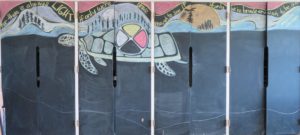
HH: Well, we appreciate your art, anyway! What do you like to do in your spare time?
YB: I’m a big reader. I also do yoga, meditate, hike, and play tennis—I like to be outside and move my body. I also enjoy going to art galleries and having dinner with friends when it’s possible. I love cooking and really miss the big dinners.
HH: Do you have a favorite hike in the GTA that you can recommend?
YB: I’m a big ravine lady! I’m missing out on the mountains that we used to have when we lived in Seoul, but I like to wander the ravines. I always go through the Mount Pleasant cemetery, down through the Brickworks, and then circle back around.
HH: When online learning is foisted upon us, what is the silver lining for you in working from home?
YB: I detest online learning and I cannot speak about a silver lining until I say that. It’s unhealthy for students and teachers; it’s unproductive and demoralizing. Having said that, the silver lining is eating lunch with my husband.
HH: Just for fun, what celebrity do people say you look like?
YB: Nobody has ever said that I look like a celebrity until this year, when my students did a celebrity lookalike for teachers. I asked them who I was, and they said Snow White. I thought that was really great because that’s my ideal life: living in the woods with birds and deer and cooking. That’s what I want!
HH: What about the dwarves?
YB: Yeah, they can hang around, I like cooking for everyone, and a good nap never hurt anybody. So Snow White works.
HH: Awesome! Thank you so much for your time today, Yarden.
About This Column
Our Meet the Community blog column gives Heschel families the opportunity to get to know some of the people who make a difference at The Toronto Heschel School.
Browse Column Archive
